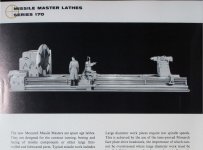I have had the pleasure of putting a Missile Master into service, and running it briefly. It is owned by the California State Railway Museum in Sacramento, CA and was surplused by Aerojet General. It was complete and set on a foundation but was not bolted down or levelled. The 25 hp motor, control box and the hydraulic unit were not installed. A friend and I volunteered to complete the installation.
We bolted and levelled the lathe, mounted the motor which sat on the top of the hydraulic tank, installed the belt drive - which had six or eight C or D section belts. We did not have foundation drawings and the location of the hydraulic unit had to align the motor sheave with the spindle sheave. That required a bit of fancy measuring with a plumb bob and tape measure. I had to make special bolts using an Axelson lathe (which I fell in love with) because the belt tension was set by the elevation of the hydraulic tank. That required long threaded bolt shanks so Simpson anchors were not suitable. The mounting bolts were within the outline of tank sides so it was not possible to set the tank and drill through ears on the outside of the tank, hence the measuring. The holes in the concrete foundation were drilled oversized, bolts installed loose, tank set on temporary cribbing over the bolts, sheaves aligned, tank elevation set enough high to be able to install and remove the belts, and the bolts grouted with epoxy. Belt tension was set by lowering the tank after the epoxy cured. I don’t remember the vertical adjustment; it must have been in the range of 10”. Thinking some more, the bolts were 1”-8 and 18” went into the foundation. Each bolt must have been about 3 or 4 ft. long.
The museum had a parallel which spanned the width of the ways and that was used to take the twist out of the bed. Vertical alignment may have left something to be desired because we only had my Starrett 199 and Polish precision levels. We marked off (IIRC) 2 foot segments along the length of the bed and charted the vertical shape. A lot of trial and error later we declared a truce and the bed may have won.
At the same time, we straightened the bed horizontally with shop made jacking brackets installed on the foundation. We used a taut wire inside the bed and measured to details on the interior of the bed. The museum will use the lathe to turn wheel sets for locomotives and rolling stock and the alignment of the lathe is not super critical. They had axle lathes farther down the machinery aisle and these have to turn straight.
I know that we aligned the tailstock with the spindle. I got to run the lathe long enough to machine a 60 deg cone on a piece of 2” bar stock. Unfortunately, I no longer remember more details of the procedure. It is possible that we made an alignment bar of the length of the axles of the wheel sets that the museum intended turn and only aligned the tailstock at that length by tramming the length of the bar from the carriage or we may have borrowed an axle.
The control box was bolted to the floor about 6 feet from the headstock, and power and control conduits installed. A bit of troubleshooting ensued and fortunately we had a schematic. I unfortunately do not remember any details of the motor controls.
The Missile Master’s next-door neighbor was Niles wheel lathe, a big brute with IIRC a 50 hp motor, that was not in service and that may be the reason for the completion of the installation of the Monarch. The Niles lathe used full width form tools and the Monarch is not capable of form turning full width. The museum will use it as a tracer lathe.

 :
:


 :
:



